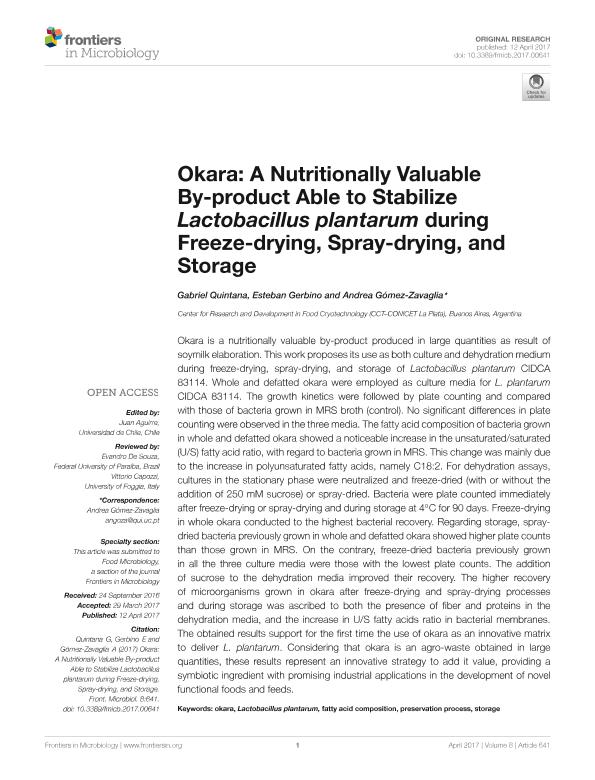Mostrar el registro sencillo del ítem
dc.contributor.author
Quintana, Gabriel Sebastian

dc.contributor.author
Gerbino, Oscar Esteban

dc.contributor.author
Gomez Zavaglia, Andrea

dc.date.available
2018-06-25T21:41:03Z
dc.date.issued
2017-04
dc.identifier.citation
Quintana, Gabriel Sebastian; Gerbino, Oscar Esteban; Gomez Zavaglia, Andrea; Okara: A nutritionally valuable by-product able to stabilize lactobacillus plantarum during freeze-drying, spray-drying, and storage; Frontiers Research Foundation; Frontiers in Microbiology; 8; 4-2017; 1-9; 641
dc.identifier.issn
1664-302X
dc.identifier.uri
http://hdl.handle.net/11336/50019
dc.description.abstract
Okara is a nutritionally valuable by-product produced in large quantities as result of soymilk elaboration. This work proposes its use as both culture and dehydration medium during freeze-drying, spray-drying, and storage of Lactobacillus plantarum CIDCA 83114. Whole and defatted okara were employed as culture media for L. plantarum CIDCA 83114. The growth kinetics were followed by plate counting and compared with those of bacteria grown in MRS broth (control). No significant differences in plate counting were observed in the three media. The fatty acid composition of bacteria grown in whole and defatted okara showed a noticeable increase in the unsaturated/saturated (U/S) fatty acid ratio, with regard to bacteria grown in MRS. This change was mainly due to the increase in polyunsaturated fatty acids, namely C18:2. For dehydration assays, cultures in the stationary phase were neutralized and freeze-dried (with or without the addition of 250 mM sucrose) or spray-dried. Bacteria were plate counted immediately after freeze-drying or spray-drying and during storage at 4°C for 90 days. Freeze-drying in whole okara conducted to the highest bacterial recovery. Regarding storage, spray-dried bacteria previously grown in whole and defatted okara showed higher plate counts than those grown in MRS. On the contrary, freeze-dried bacteria previously grown in all the three culture media were those with the lowest plate counts. The addition of sucrose to the dehydration media improved their recovery. The higher recovery of microorganisms grown in okara after freeze-drying and spray-drying processes and during storage was ascribed to both the presence of fiber and proteins in the dehydration media, and the increase in U/S fatty acids ratio in bacterial membranes. The obtained results support for the first time the use of okara as an innovative matrix to deliver L. plantarum. Considering that okara is an agro-waste obtained in large quantities, these results represent an innovative strategy to add it value, providing a symbiotic ingredient with promising industrial applications in the development of novel functional foods and feeds.
dc.format
application/pdf
dc.language.iso
eng
dc.publisher
Frontiers Research Foundation

dc.rights
info:eu-repo/semantics/openAccess
dc.rights.uri
https://creativecommons.org/licenses/by/2.5/ar/
dc.subject
Fatty Acid Composition
dc.subject
Lactobacillus Plantarum
dc.subject
Okara
dc.subject
Preservation Process
dc.subject
Storage
dc.subject.classification
Alimentos y Bebidas

dc.subject.classification
Otras Ingenierías y Tecnologías

dc.subject.classification
INGENIERÍAS Y TECNOLOGÍAS

dc.title
Okara: A nutritionally valuable by-product able to stabilize lactobacillus plantarum during freeze-drying, spray-drying, and storage
dc.type
info:eu-repo/semantics/article
dc.type
info:ar-repo/semantics/artículo
dc.type
info:eu-repo/semantics/publishedVersion
dc.date.updated
2018-06-25T16:12:13Z
dc.journal.volume
8
dc.journal.pagination
1-9; 641
dc.journal.pais
Suiza

dc.journal.ciudad
Lausana
dc.description.fil
Fil: Quintana, Gabriel Sebastian. Provincia de Buenos Aires. Gobernación. Comisión de Investigaciones Científicas. Centro de Investigación y Desarrollo en Criotecnología de Alimentos. Consejo Nacional de Investigaciones Científicas y Técnicas. Centro Científico Tecnológico Conicet - La Plata. Centro de Investigación y Desarrollo en Criotecnología de Alimentos. Universidad Nacional de La Plata. Facultad de Ciencias Exactas. Centro de Investigación y Desarrollo en Criotecnología de Alimentos; Argentina
dc.description.fil
Fil: Gerbino, Oscar Esteban. Provincia de Buenos Aires. Gobernación. Comisión de Investigaciones Científicas. Centro de Investigación y Desarrollo en Criotecnología de Alimentos. Consejo Nacional de Investigaciones Científicas y Técnicas. Centro Científico Tecnológico Conicet - La Plata. Centro de Investigación y Desarrollo en Criotecnología de Alimentos. Universidad Nacional de La Plata. Facultad de Ciencias Exactas. Centro de Investigación y Desarrollo en Criotecnología de Alimentos; Argentina
dc.description.fil
Fil: Gomez Zavaglia, Andrea. Provincia de Buenos Aires. Gobernación. Comisión de Investigaciones Científicas. Centro de Investigación y Desarrollo en Criotecnología de Alimentos. Consejo Nacional de Investigaciones Científicas y Técnicas. Centro Científico Tecnológico Conicet - La Plata. Centro de Investigación y Desarrollo en Criotecnología de Alimentos. Universidad Nacional de La Plata. Facultad de Ciencias Exactas. Centro de Investigación y Desarrollo en Criotecnología de Alimentos; Argentina
dc.journal.title
Frontiers in Microbiology
dc.relation.alternativeid
info:eu-repo/semantics/altIdentifier/url/https://www.frontiersin.org/articles/10.3389/fmicb.2017.00641/full
dc.relation.alternativeid
info:eu-repo/semantics/altIdentifier/doi/http://dx.doi.org/10.3389/fmicb.2017.00641
dc.relation.alternativeid
info:eu-repo/semantics/altIdentifier/url/https://www.ncbi.nlm.nih.gov/pmc/articles/pmid/28446905/
Archivos asociados
